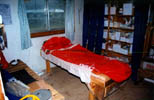There are three major issues I did want to touch upon here:
- On the Khumbu park entrance gates at Jorsalla there is a large sign saying "Go slowly, altitude kills". This means exactly what is says - altitude sickness is no joke. It can happen to anyone anywhere along the high altitude treks and is potentially life threatening. In the HRA post in Pheriche, we have seen two people nearly die from AMS (evacuated by helicopters in a comatose near death state.)
- Having AMS isn't the end of a trek - Having been very fit for the trek, I imagined that there shouldn't be any problem with heights. I was wrong. Every time we climbed a couple of hundreds of meters (almost every day) after we got to our new guest house a strong headache would set in. We would stay for the night and the headache would go away in the morning. Having been aware of this acclimatization effect, we went on very slowly staying extra acclimatization days in Namche, Tengboche and Pheriche. It is this awareness that kept us going very slowly till we got to Kalla Patar. So having AMS isn't the end of the trek, it just means that a certain course of action needs to be taken.
- Read all about it - I strongly recommend (especially based on my experience with AMS) to read everything one possible can on the subject. Suggested reading materials are the Lonely Planet trekking book as well as the HRA site.
 A picture of the HRA aid post in Pheriche treatment room. The red bag in
the picture is a "Gamow Bag" which is a sealed sleeping bag like enclosure
into which air is pumped by foot to create a increased pressure effect.
A picture of the HRA aid post in Pheriche treatment room. The red bag in
the picture is a "Gamow Bag" which is a sealed sleeping bag like enclosure
into which air is pumped by foot to create a increased pressure effect.